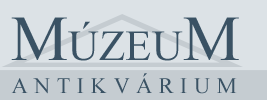categories
- Traffic and Vehicles Catalogue
- socreal.catalog
- Advertisement Catalogue
- Photo Catalogue
- Chinese and Japanese Catalogue
- New Holy Card Catalogue II.
- 12 interesting old books
 Books
Books
 Bibliophil
Bibliophil
 Antiques
Antiques
 Engraving
Engraving
 Maps
Maps
 Photos
Photos
 Antique Papers, Small Prints
Antique Papers, Small Prints
 Posters
Posters
- Circus
- Modern Graphics
- Socialist Realism
- NER Propaganda
- Others
cart
Németh Zsófia (Ed.) : Women at the Gödöllő Artists' Colony
- description
- additional information
The exhibition presents works of art by females who worked at the
Gödöllő Colony of Artists in the first half of the 20th century. Two of
the artists were Mariska Undi and Laura Kriesch, who graduated from the
predecessor of the Hungarian University of Fine Arts. Carla Undi and
Vilma Frey did courses, in relations with the Gödöllő weaving school.
They were scholars of the School of Applied Arts. Basic education of the
Frey girls was provided by Árpád Juhász in Zombor. He, before he moved
to Gödöllő was a private tutor for Gabriella, Vilma and Rózsa Frey.
Women of the middle or higher classes were privately educated on art or
music at the artist colony in the second half of the 19th century and
the first half of the 20th century. By law, women had the right to go to
collages or universities. However, society needed tome to adapt to
this. Families had to make financial sacrifices to provide higher
education to girls. It was not natural that girls studied more than
housekeeping, or any basic education. Running a household, especially if
it was a bigger one, was not an easy task and it was the job of the
females.
Education of women was to prepare them for living independently of men.
In addition, it was also to lessen the poverty of women at the end of
the 19th century. The historic and social background added a lot to the
beginning of household industry, later schools of arts and crafts.
Specialized schools open one after another across Hungary. Bee-keeping
and poultry keeping training was offered for the first time, and
training of housewives was under consideration. Courses were offered
across the country, and also art studios where trainees could master
weaving, like in Gödöllő.
The review of the weaving school in Gödöllő is highlighted at the
exhibition. Vilma Frey came to Gödöllő after the school’s nationwide
advertisement campaign because she could not find a job according to her
skills. Then, she invited her sisters, too. She and Rózse moved to live
in Gödöllő. Their sister, Gabriella (Ella) was by then married to the
lawyer Dr. Lehel Knézy. She did not move to Gödöllő, but was somewhat
involved in the work at the colony, together with her children and
husband. In his childhood, she was privately taught to paint and
practiced it throughout her life.
Mariska Undi and her sisters, Carla és Jolán, also came to study at the
weaving school. Later on Lenke Boér joined them from Diód, Transylvania.
Jolán Undi and Lenke Boér, after learing the skill graduated from the
weaving school. Their names are often mentioned in contemporary
exhibition flyers and related literature.
Laura Kriesch's brother was invited by Aladár Körösfői-Kriesch together
with her husband, Sándor Nagy where he worked as a graphic artist and
designer.
Equality of women in Gödöllő prevailed much more than it was customary
those days. However, we must not forget that leading artists were all
men even in Gödöllő. The only woman who dedicated her life completely to
art was Mariska Undi. All the others married and had children. They
even signed their married names on the works.
.. .. .. .. ..
Kiállítás, amely Keserü Katalin művészettörténész koncepciója alapján a gödöllői művésztelepen alkotó női művészeket mutatta be . Körösfői-Kriesch Aladár, Nagy Sándor alkotásain a 19. századi hősök helyett hősnők jelennek meg, a világ és önmaguk megismerésére törekvő nőalakok, akik maguk is alkotók és akiket a férfiak - eltérően a "végzet asszonya" korabeli kultuszától - társnak tekintettek. Ebben az életközösségben, ami a művésztelepi közösség alapját jelentette, felértékelődött a hagyományos női tevékenység, minden olyan munka, ami az otthonnal volt kapcsolatos, művészi jelentőséget nyert. A paraszti életmód felfedezése is befolyásolta ezt a szemléletet. A kiállítás bemutatta a hagyományos nőkép megváltozását a gödöllői művésztelepen, a nőművészek (Undi Mariska, Undi Carla, Kriesch Laura, Frey Vilma) tevékenységét, a női munkán alapult szövőműhely működését, tágabbra tekintve azokat az építészeti és belsőépítészeti törekvéseket is, melyek az életközösségek otthonát voltak hivatva megteremteni.
| condition: |      |
| category: | Books > Foreign Language Books > Books in English > |
| category: | Books > Arts > Art history > |
| category: | Books > Arts > Fine Arts > exhibition catalog > |
| publisher: | Hungarian Cultural Centre, 2004 |
| item number / ISBN: | 0039502 |
| binding: | paperback |
| pages: | 47, [24] p. (képek) |
| language: | English |









 Telefon:
Telefon: E-mail:
E-mail:







